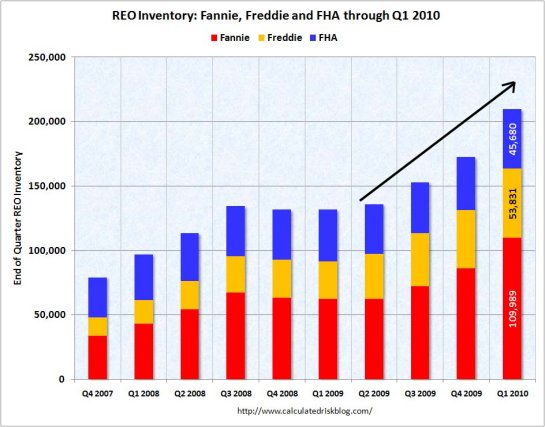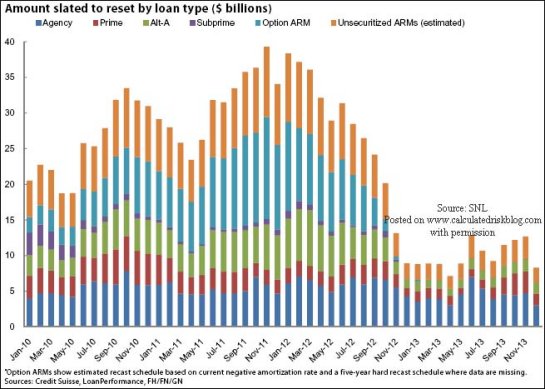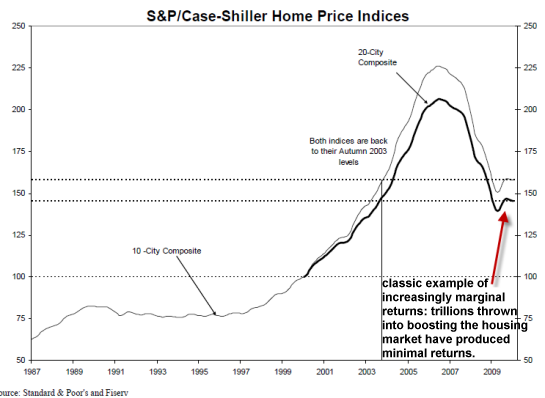This shadow inventory could reach as high as 7 million homes by some estimates;
other analysts reckon it will
take 103 months (about 8.5 years) to clear this
gigantic inventory of foreclosed, distressed and defaulted homes.
To put these numbers in context:
according to the U.S. Census Bureau, 51 million households have a mortgage and
24 million own homes free and clear (no mortgage), and about 37 million households rent.
Consider a fact that might be considered staggering in an environment in which "obvious" isn't
quite so manipulated:
the total number of vacant dwellings in the U.S. increased to
a record 19 million in the first quarter of the year, up from 18.9 million in the
fourth quarter. As new homes continued to be constructed, the housing inventory
rose last year by 1.14 million to 130.9 million, while occupied homes increased by
1.07 million to 111.9 million.
The Census Bureau reckons about 4 million of those vacant housing units are
vacation or second homes. Even if millions more of these vacant homes are in undesirable areas few
or suffering from severe structural issues, that still leaves
well over 10 million vacant dwellings in the U.S.--a truly monumental overhang of supply.
This inventory of vacant and/or defaulted dwellings is not static: as this chart
illustrates, the inventory of defaulting loans reverting to
Fannie Mae, Freddie Mac and the FHA is rising.

Then there is the looming surge of mortgage re-sets which will continue through 2012:

Given the imbalance between supply and demand, some housing observers are issuing
forecasts of 50% declines in housing values.
As I have noted here many times, the intervention in the nation's mortgage market
by the Federal Reserve and the Federal government via its GSEs Fannie and Freddie and its
housing loan agencies FHA and VA, is absolutely unprecedented in size and scope.
Government-backed loans accounted for 99%, or $1.5 trillion, of mortgage securities
in 2009. Banks and other private firms have issued a mere $15 billion. In addition,
the Federal Reserve and Treasury have spent nearly $1.25 trillion buying those bonds
to support the housing and broader credit markets. "The government is literally plowing
trillions of dollars into the U.S. mortgage market to keep it afloat," says Guy D.
Cecala, publisher of Inside Mortgage Finance.
And what has been the result of this complete Federal/Fed absorption of mortgage risk?
A very modest blip up in home valuations, in certain highly desirable areas of the
nation. This is marginal returns writ large:

The Federal Reserve's exit from buying mortgages (if in fact it has actually ceased
propping up the nation's mortgage market) will eventually cause
mortgages to either rise in cost and/or become less readily available. Some analysts
see this unprecedented Fed intervention in what were once largely private mortgage
markets to be a development with
highly negative consequences going forward.
It is an understatement to say that the Fed, the Federal Housing Administration (FHA) and the government-sponsored
housing agencies, Fannie Mae and Freddie Mac, have not managed mortgage risk
very well;
FHA problem loans have risen to 24% of all loans originated in 2007,
and
taxpayers face $1 trillion in losses on Fannie and Freddie alone in the
years ahead.
The U.S. housing market is one defined by a rising supply and faltering demand,
and a total dependency on a
mortgage market propped up by
government or quasi-government agencies which have shown poor risk management in
service of sustaining or reinvigorating an unsustainable credit bubble.
These stupendous government interventions have simply staved off the consequences
of the supply-demand imbalance for the past two years. At some point these interventions
will fail and the returns on the investment will go negative: all the trillions
of dollars committed to propping up housing prices will fail to boost prices at all.
At that point public support for the prop-job will evaporate and the market will finally
get a chance to clear the imbalance between supply and demand.
Thank you, readers and contributors: As a result of your readership
and support, oftwominds.com is now a Page Rank 6 site. This may not seem like a big
deal, but the Google Page Rank is a basically impossible to "game" measure of
influence: not just the number of visitors or links, but a measure of link-ins,
scope and reach of content, etc. I am honored and humbled to reach PR 6. Special
thanks to Mary for suggesting the cool "Page Rank history" graphic in the right
sidebar.
If you would like to post a comment where others can read it, please go to
DailyJava.net,
(registering only takes a moment), select Of Two Minds-Charles Smith, and then go to The daily topic.
To see other readers recent comments, go to
New Posts.

Order Survival+: Structuring Prosperity for Yourself and the Nation and/or
Survival+ The Primer
from your local bookseller or from amazon.com or in ebook
and
Kindle formats
. 
